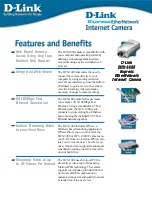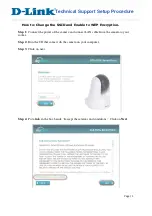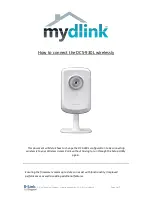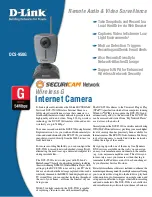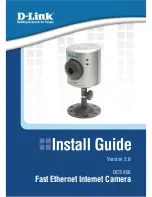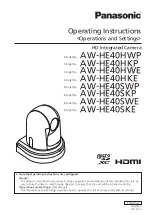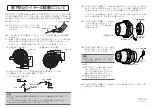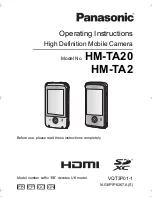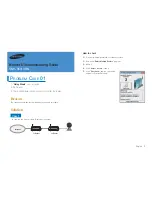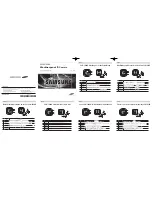
CAMIR-NCS & CAMIR-NCSH: PIR Sensor with Camera – Installation Instructions (ENGLISH)
!
1. Introduction
These volumetric sensors uses passive infra-red technology, and has a built in
night vision color camera and heat sensor (CAMIR-NCSH only).
CAMIR-NCS and CAMIR-NCSH sends an intrusion alarm, when an intruder
enters the surveillance area. CAMIR-NCSH sends a heat alarm when the room
temperature exceeds an abnormal fixed temperature value of 54°C. Heat alarm
indicates a high suspicion of fire.
Upon configuration, on both cases CAMIR-NCS and CAMIR-NCSH, takes
a series of pictures and send to the alarm receiving centre through the control
panel for verification.
The CAMIR- NCS and CAMIR-NCSH sensors are part of the range of radio
peripherals used with the Domonial 800 control panel.
Special Instructions for Installing with Pets
To take full advantage of the pet immunity in the CAMIR- NCS and CAMIR-NCSH
sensor, follow the guidelines below:
• Set the sensor to the Low sensitivity where the total combined weight of
animals may not exceed 36 kg (80 lb).
• Mount the sensor where pets cannot come within 1.80 m (6 feet) of the sensor
by climbing on furniture, boxes or other objects.
• Do not aim the sensor at stairways or furniture/objects that can be climbed
on by animals.
• Environmental differences and the amount of heat radiated by an animal
will vary the animal immunity levels exhibited by the sensor.
Sensor must have a clear line-of-sight to protected area (see figure 1 for
mounting location recommendations).
Each installation should be tested to determine the exact level of animal immunity
attainable.
!
2. Mounting
Tamper Switches
The CAMIR- NCS and CAMIR-NCSH sensor is equipped with a normally-closed
cover tamper. This tamper opens when the cover is opened.
Two wall tampers are provided:
• Operational when the sensor is fixed flat against a wall.
• On one angle, operational when the sensor is fixed at an angle (see Figure 3).
Mounting Instructions
•
Using a small screwdriver, push in the housing latch at the bottom of the
sensor and gently remove the front cover, lifting it from the bottom (see
figure 2).
• Hold the batteries in place, and pull out the battery tab to power up the sensor.
You can register the sensor immediately or at a later time.
• Mount the rear housing flat against a wall or in a corner using screws placed
in the mouting holes (see Figure 4).
!
3. LED operation
Use the programming tool to enable/disable the LED (see Figure 5).
!
4. Registration
Registration on a Domonial panel
Registration is the procedure that associates the detector with the control panel.
This operation requires a programming tool based on smartphone or PC,
or the TCU keypad. The complete procedure is described in the user manuals
of these tools.
• Connect the programming tool to the control panel and enter programming
mode.
• Select the item
Add New Device
.
• Remove the battery tab or activate the tamper by opening and closing the
cover of the sensor. A confirmation message appears after several
seconds, indicating the registration of the sensor at the control panel, together
with the radio type, radio signal level and the serial number of the device.
• Choose the function mode, the label, etc.
!
Warning: The sensor must always be registered in its final position with
a minimum radio signal level of 4/10
5. Configuration
The CAMIR- NCS and CAMIR-NCSH sensor is configured using a programming
tools. The following detector settings can be configured:
• LED and PIR sensitivity
• Picture resolution, number of imgaes and interval between the images
• Heat alarm and heat alarm picture (CAMIR-NCSH only).
Setting Sensitivity and Testing the Sensor
Set the sensitivity appropriate for the application (see the options below), and
replace the cover. Begin the walk-test as soon as the LED stops blinking. Walk
through the detection zone(s), observing the sensor’s LED. The LED indicates
detection of movement and transmission of an alarm.
The absolute range of a sensor unit is subject to variation due to different clothing
types, backgrounds and ambient temperature. For this reason, you should ensure
that the most likely intruder routes are well within the sensor’s detection zones,
and that walk-testing is carried out along those routes.
Sensitivity Options
•
Low Sensitivity: 3-5 steps. This is the recommended setting for applications
with pets up to 36 kg.
• Medium Sensitivity. 1-3 steps.
• High Sensitivity: 1-2 steps. This is the recommended setting for any location
where an intruder is expected to cross only a small portion of the area covered.
Recommended for High Security applications (Conforms to EN50131).
!
Note: The distances in the detection pattern illustrations are only given
as a guide, and do not represent the maximum detection distances
!
6. Walk-Test Mode
After the warm-up period (2 min 30 sec), when the cover is closed (operation of
the tamper switch) the product enters into test mode for 10 minutes. This test is
mandatory to ensure proper detection. Each detection results in an alarm signal
being sent. To restart the 10-minute test period, operate the tamper switch.
!
7. Heat alarm test
(CAMIR-NCSH only).
After the Walk test, it is recommended that the heat alarm is also tested.
To trigger the test mode, short the test pads for minimum 15 second as shown
in the picture below.
During the test mode, sensor will send a heat alarm to the control panel. Sensor
will exit the test mode automatically.
Depends on environmental temperature, the heat alarm restore might take up
to 10min.
Note1: Don’t use too hot air flow, lighter, match, soldering gun or similar source
which creates too high temperature, and will damage the sensor permanently.
Note2: Enable “Heat alarm” feature through the prog tools, to activate the siren(s)
when performing the test.
!
!
8. Battery Failure
The sensor signals a battery failure at the control panel when the battery needs
to be replaced. The sensor will continue to operate for up to one month after this,
but the photo functionality will be disabled.
Note: that if the batteries are weak, the photo function of the sensor will not work.
Battery Removal & Handling Safety Warning: Risk of fire, explosion and burns.
Do not recharge, disassemble, heat above 100° C, or incinerate the battery.
Use care when changing the battery to ensure that the battery is not damaged and the
terminals are not shorted during removal. If the battery is damaged, use personal
protective equipment to remove it immediately, and dispose of it in a safe manner (refer
to the battery manufacturers specifications). Comply with applicable national and local
regulations to dispose of depleted batteries.
For Switzerland, Annex 4.10 of SR 814.013 applies to the battery included with
this product.
!!
For all enquiries, please visit your local Honeywell website.
-
!
-
1









